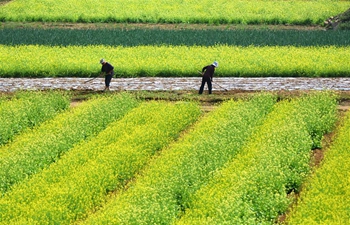BEIJING, May 10 (Xinhua) -- Chinese researchers have completed the genome sequencing of the wheat A subgenome, and generated a high-quality draft of its chromosomes, which could promote genetic improvements in cultivated wheat.
The study by researchers at the Institute of Genetics and Developmental Biology was published in the journal "Nature" Thursday.
Researchers have generated a molecular map of seven chromosomes of the wheat A subgenome and identified 41,507 protein-coding genes, providing high-quality genomic information and a new perspective for studying genetic variation in wheat.
Commonly cultivated wheat contains three genomes: A, B and D. They are huge and complex, about 40 times larger than rice genomes. More than 85 percent of the genome DNA of wheat is repetitive, making the study of its genome sequencing difficult.
Wheat is one of the world's most important food crops, feeding 40 percent of the world's population and providing 20 percent of heat and protein that humans need.
China produces and consumes a large amount of wheat, producing about 130 million tonnes on 24 million hectares each year.
Researchers believe the sequencing will help improve competitiveness in the wheat industry, safeguard food security, and boost the quality and efficiency as well as sustainable development of agriculture.

















